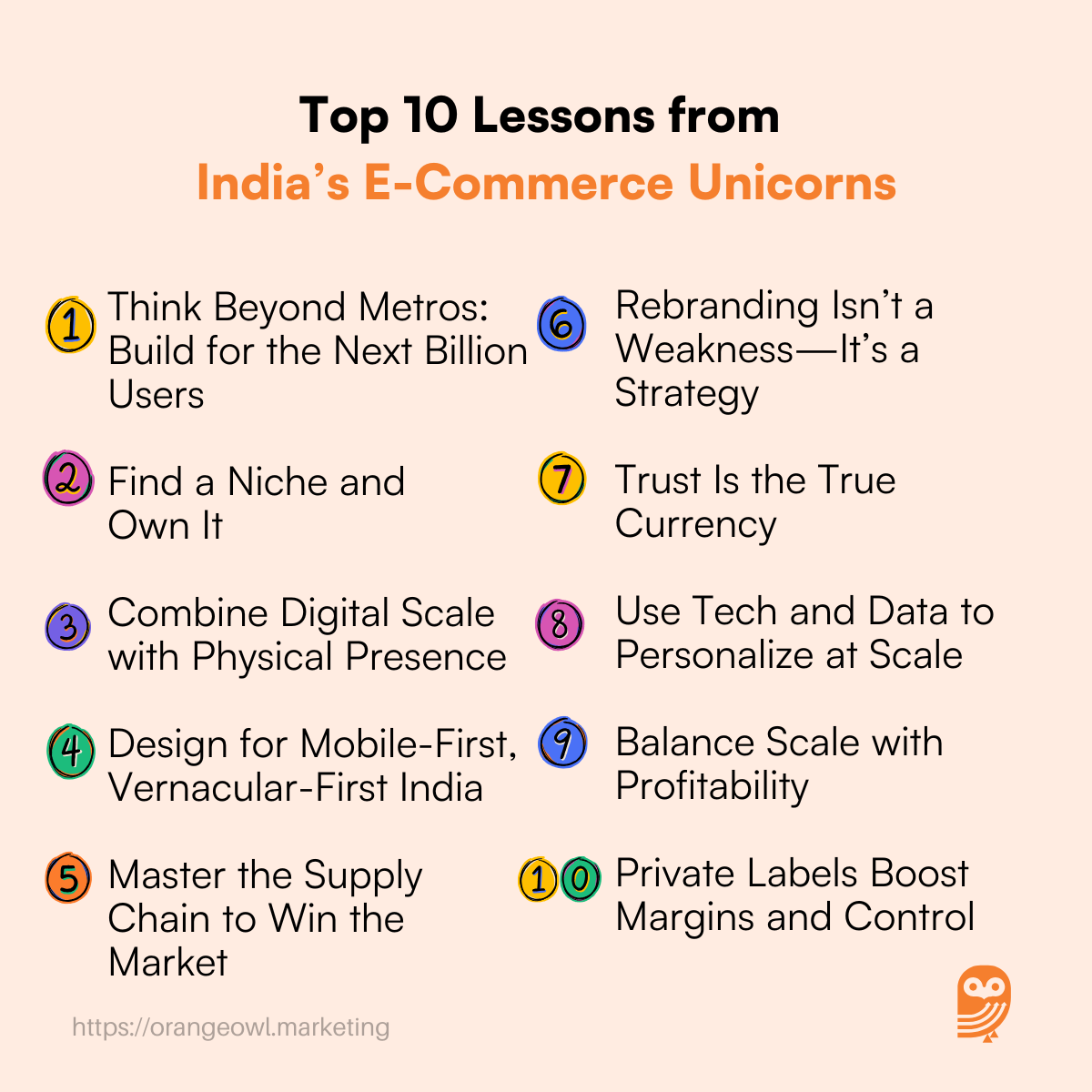10 Insightful Lessons from India’s E-Commerce Unicorns
Vivek Goel
May 26, 2025

Table of Contents
Introduction
India’s e-commerce landscape has undergone a transformative decade, evolving into one of the world’s fastest-growing digital marketplaces. With internet penetration projected to surpass 900 million users by 2025, driven significantly by rural growth , and Unified Payments Interface (UPI) transactions reaching ₹23.95 lakh crore in April 2025 , the country is experiencing an unprecedented digital retail revolution.
According to Bain & Company, India’s e-retail market is estimated to increase to $150 billion–$170 billion by 2027, implying a 25%–30% annual growth and a doubling of market penetration to 9%–10% over the next five years .
This dynamic environment has produced a powerful cohort of e-commerce unicorns—startups valued at over $1 billion—that have not only scaled operations but redefined how Indian consumers shop, interact, and engage. These unicorns span categories from social commerce and quick delivery to beauty, parenting, and B2B procurement.
From Meesho’s reseller-led growth in Tier 2+ towns to Lenskart’s tech-powered omnichannel eyewear model, each of these 15 companies has contributed a vital piece to India’s e-commerce puzzle. They offer real-world lessons in innovation, localization, logistics, and customer trust—principles every entrepreneur, investor, or marketer can learn from.
This blog distills the key takeaways from 15 Indian E-commerce Unicorns and What You Can Learn from Their Success, connecting their journeys to 10 actionable lessons that reveal what it takes to build enduring, scalable ventures in a fast-moving market.
1. Think Beyond Metros: Build for the Next Billion Users
India’s e-commerce opportunity doesn’t lie only in urban centers—it thrives in the heartlands. Meesho, ShopClues, and DealShare realized early that the next wave of digital consumers would come from Tier 2, Tier 3, and rural areas, where affordability, trust, and ease of access drive decisions.
Meesho became a household name by enabling homemakers and micro-entrepreneurs—especially women in small towns—to start their online reselling businesses without inventory or upfront capital. Its mobile-first interface, regional language support, and social selling features made entrepreneurship accessible to millions.
DealShare took a hyperlocal approach, crafting a product catalog and user experience tailored to the needs of value-conscious middle-income families in smaller cities. Group buying, local supply sourcing, and regional offers added to its relevance.
ShopClues differentiated itself by offering budget-friendly, unbranded merchandise to price-sensitive customers, particularly in semi-urban and rural regions. It became a platform for the “value shopper” long before others caught on.
Lesson: Don’t just build for India’s top 100 million internet users—build for the next billion. Designing for Bharat means prioritizing simplicity, affordability, vernacular content, and trust. This isn’t a compromise—it’s a scalable growth strategy.
2. Find a Niche and Own It
Many Indian e-commerce unicorns succeeded not by going wide but by going deep. They chose a niche, built unmatched trust within it, and became synonymous with that category.
Purplle focused on the mid-income beauty segment, offering affordable products and personalized shopping experiences through data-backed recommendations and an inclusive product lineup.
FirstCry tapped into an emotionally charged and high-trust segment: parenting. By becoming the one-stop shop for everything related to babies and toddlers, FirstCry earned deep customer loyalty.
Nykaa built its empire around beauty and wellness for women, combining premium product access with powerful content, community building, and influencer-led storytelling. Its deep vertical expertise gave it a lasting edge, even against horizontal players like Amazon and Flipkart.
Lesson: Master your category. Before expanding, dominate a niche so well that customers can’t think of anyone else.
3. Combine Digital Scale with Physical Presence
Omnichannel retail isn’t just an option in India—it’s a strategic imperative. Despite the rise of online shopping, offline channels continue to play a crucial role in building trust, offering touch-and-feel experiences, and enabling discovery in a country where shopping is still largely emotional.
Nykaa used its stores not only to showcase products but also to offer live beauty consultations and events—transforming brand interaction into a sensory experience.
Lenskart blended digital and physical through virtual AR try-ons, home eye tests, and smart retail stores equipped with real-time analytics and guided consultations.
FirstCry adopted a franchise-led offline model, setting up over 400 stores that supported its online operations and extended its brand presence, especially in Tier 2 and Tier 3 cities.
Lesson: Physical presence builds credibility and emotional connection. When done right, online + offline is a flywheel that strengthens brand loyalty and drives higher conversions.
4. Master the Supply Chain to Win the Market
India’s complex geography and fragmented infrastructure pose massive challenges to e-commerce. Unicorns that built proprietary logistics systems gained a clear competitive advantage.
BigBasket invested heavily in its own warehouses, cold chain infrastructure, and last-mile delivery fleet. This allowed it to ensure freshness, punctuality, and consistency—key expectations in grocery delivery.
Blinkit (formerly Grofers) pioneered the dark store model to enable 10-minute delivery in dense urban clusters, optimizing for speed without compromising inventory control.
Udaan tackled the B2B commerce challenge by digitizing wholesale distribution, creating a tech-enabled supply chain that connected retailers, manufacturers, and logistics providers across India’s vast hinterland.
Lesson: Don’t outsource your core operational moat. In India, logistics isn’t just a function—it’s a differentiator. Owning the supply chain enables service consistency, speed, and cost control.
5. Design for Mobile-First, Vernacular-First India
In India, over 80% of internet users access the web primarily through mobile phones. Most of them are first-time users, often unfamiliar with English and seeking intuitive, regional-language interfaces.
Meesho won millions of users by offering a simple, WhatsApp-integrated user experience and regional onboarding. Its interface was designed for ease-of-use by those with limited digital literacy.
DealShare incorporated multiple Indian languages and culturally relevant UI/UX flows to engage non-English-speaking consumers.
Snapdeal, after a strategic pivot, reoriented its app design to appeal to Bharat shoppers—focusing on affordability, local deals, and an interface that removed complexity.
Lesson: Build for where India is—not where Silicon Valley is. Mobile-first, vernacular-ready design ensures access, trust, and mass adoption.

6. Balance Scale with Profitability
In India’s early e-commerce boom, Gross Merchandise Value (GMV) was often mistaken for success. Companies raced to acquire users and expand reach—even at the cost of burning cash. However, the survivors and long-term winners realized that sustainable growth, backed by sound economics, ultimately defines longevity.
Snapdeal made headlines during its hypergrowth phase but later chose to prioritize value-commerce and profitability. By stepping away from direct competition with Amazon and Flipkart, it focused on serving budget-conscious consumers with a curated product range and lean operations.
Paytm Mall also recalibrated. After experimenting with deep discounting and GMV-centric expansion, the company pivoted to strengthen its focus on logistics, merchant services, and sustainable unit economics.
ShopClues, operating in a razor-thin margin category, implemented aggressive cost optimization and operational efficiency measures to stay afloat and relevant.
Lesson: Growth is essential, but not at the cost of burning out. Unicorns that balance scale with profitability build more resilient, future-ready businesses.
7. Use Tech and Data to Personalize at Scale
In a market as diverse as India, one-size-fits-all doesn’t work. Unicorns that invested in smart technologies not just for automation, but for personalization, have seen stronger customer retention and satisfaction.
Lenskart took eyewear personalization to a new level. From AI-based eye exams to AR-powered virtual try-ons and doorstep home trials, the brand offered seamless tech experiences while addressing trust and fit issues in eyewear purchases.
Purplle utilized AI to analyze user preferences, skin tones, and budget constraints—offering personalized beauty product recommendations. This created a more engaging, curated experience, especially for users new to online cosmetics.
Nykaa went a step further by mining customer behavior and feedback to launch its own successful D2C labels. These brands weren’t just opportunistic—they were tailored to gaps in customer needs revealed by data.
Lesson: Personalization is no longer a premium feature—it’s an expectation. Use tech and data not just to scale operations, but to make each customer feel personally understood.
8. Rebranding Isn’t a Weakness—It’s a Strategy
In startup culture, pivots are often inevitable. The ability to redefine your identity in line with changing market needs is a strength, not a setback. For India’s e-commerce unicorns, rebranding has often signaled not failure—but renewed purpose and sharper positioning.
Grofers saw early success in scheduled grocery delivery but realized that Indian consumers were increasingly moving toward instant gratification. It rebranded as Blinkit, embracing a bold shift to 10-minute grocery delivery with hyperlocal dark stores.
Snapdeal, once dubbed the third wheel in the Amazon vs. Flipkart race, strategically repositioned itself as a value-first e-commerce platform focused on non-branded goods. This pivot allowed it to reconnect with its original user base in Bharat.
Lesson: Reinvention is not a sign of weakness—it’s a sign of leadership. In dynamic markets like India, adapting quickly is the only constant.
9. Private Labels Boost Margins and Control
Owning the product—rather than just distributing it—can be a game-changer. Private labels not only offer better profit margins, but also improve quality control, brand identity, and customer loyalty.
BigBasket created in-house brands like Fresho (fruits, vegetables) and BB Royal (staples), ensuring quality consistency and improving margins in low-profit categories like groceries.
Purplle launched its own skincare and beauty lines such as Good Vibes, offering affordability and control over ingredients and positioning. These brands now contribute significantly to revenue and help differentiate the platform.
Nykaa’s private labels—including Nykaa Cosmetics, Nykaa Naturals, and Kay Beauty—are among the top-selling brands on the platform, reinforcing brand equity while enhancing profitability.
Lesson: When you own the label, you own the customer experience—and the margin. Private brands are not just add-ons; they are strategic levers.
10. Trust Is the True Currency
In the Indian market, trust beats convenience, variety, or even price—especially in high-involvement or sensitive categories. For e-commerce brands, this means consistency, transparency, and reliability must be non-negotiable.
Lenskart’s “Try at Home” model broke a major trust barrier by letting users physically try eyewear before purchase. This blend of service and product instilled confidence in a category historically reliant on in-store experience.
PharmEasy focused heavily on authenticity, especially given the sensitivity of the health category. Ensuring genuine medicines, timely deliveries, and access to prescriptions helped it build strong consumer trust in a space fraught with skepticism.
FirstCry understood that new parents are some of the most risk-averse consumers. It built a safe, informative ecosystem—including parenting forums, blogs, and user reviews—to foster community-based trust.
Lesson: In Indian e-commerce, trust is not a byproduct—it’s the product. Every click, delivery, and interaction either builds or erodes it.
Conclusion: From Lessons to Legacy
India’s e-commerce unicorns didn’t just build platforms—they redefined digital entrepreneurship for emerging markets. Each company navigated challenges like infrastructure limitations, low digital literacy, and deeply fragmented consumer behavior—emerging stronger by innovating for local realities rather than copying global templates.
Whether it was Meesho unlocking Bharat through reseller empowerment, Blinkit redefining delivery speed, or Nykaa blending content with commerce, these startups set blueprints for building iconic brands in complex markets.
As the ecosystem shifts with the rise of ONDC, AI-driven personalization, and social-first commerce, future unicorns may emerge from even narrower niches—rural-first platforms, creator-led brands, and micro-category aggregators.
If you’re starting, scaling, or pivoting today—these 10 lessons offer more than strategy. They offer conviction.


